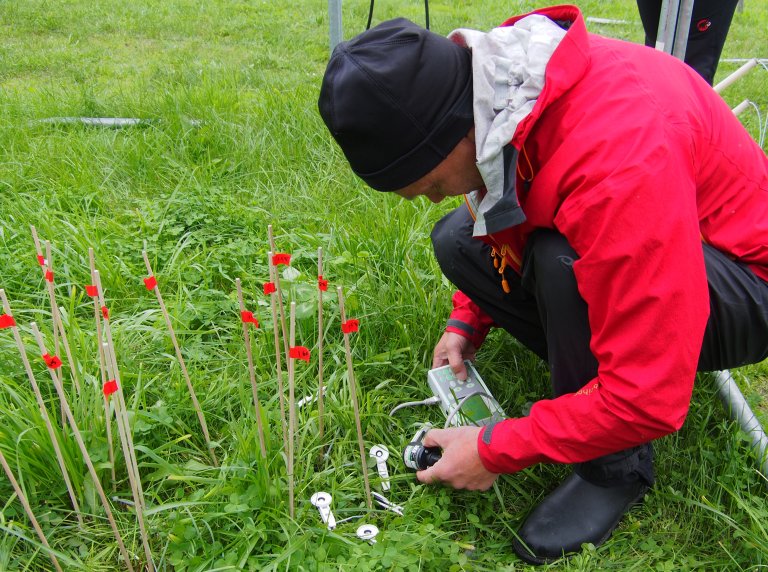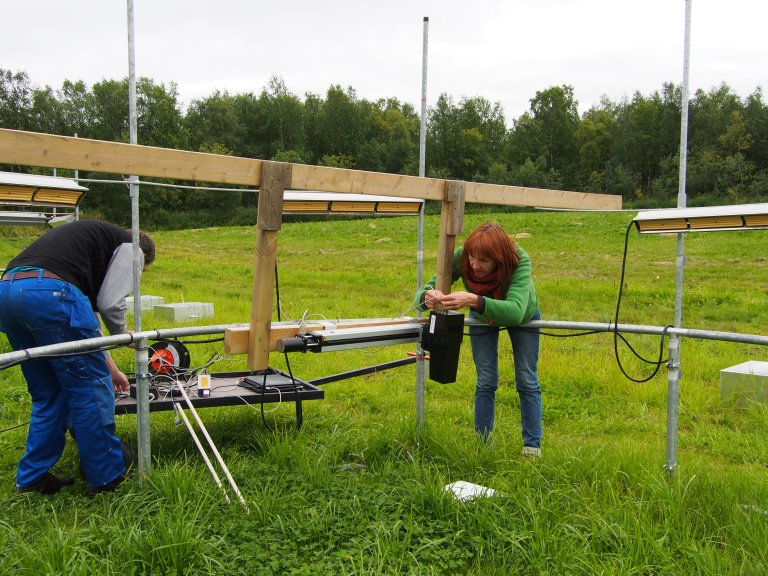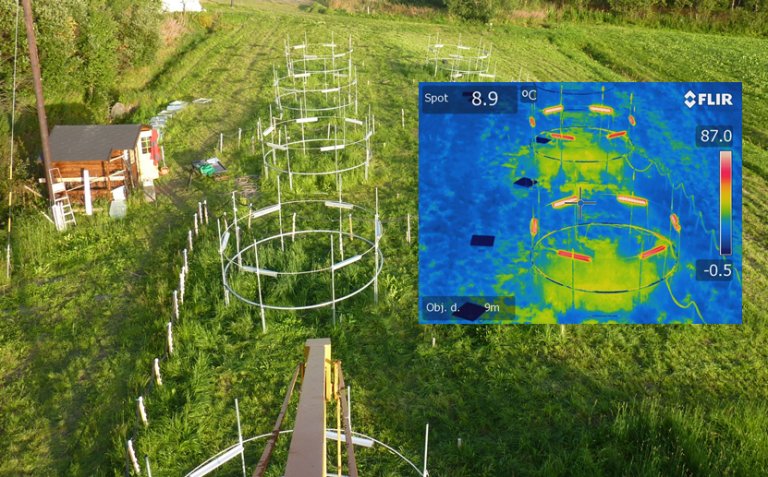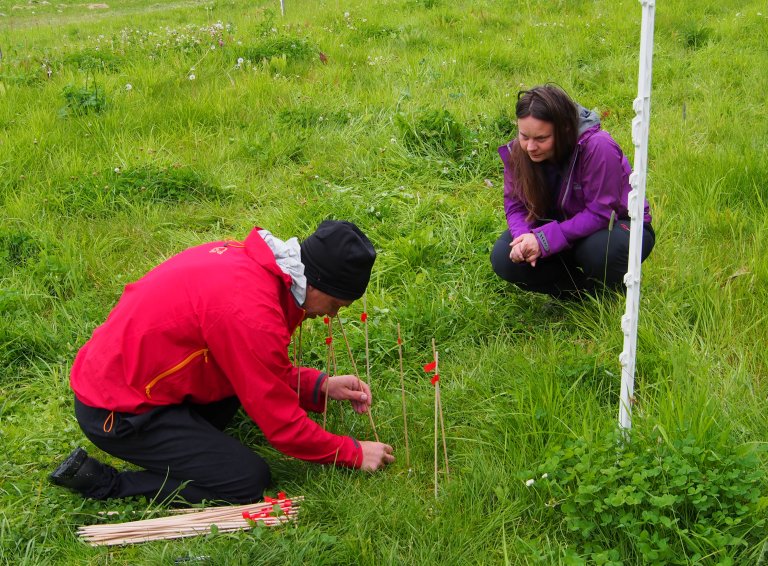Warming up northern meadows

Warmed plots after a frosty autumn night in the Pasvik valley. Photo: Hanna Silvennoinen.
In what ways will meadows in climatic areas similar to the arctic respond to a temperature increase of three degrees? By conducting an extensive ecosystem warming experiment involving trampoline frames, infrared heaters and hyperspectral cameras, this is what researchers have spent the last few years trying to figure out.
Way up north, in the Pasvik valley close to the Norwegian-Russian border, lies Svanhovd, a research station belonging to the Norwegian Institute of Bioeconomy Research, NIBIO. The climate in this secluded area is typical for arctic regions, with long, icy cold winters and short, light summers. For two months each year, however, the sun does not set, and in July the temperature can rise to 20 degrees. This renders it possible to carry out fodder production in the region, albeit with a growing season of maximum 110-120 days.
With temperatures anticipated to rise three degrees in future, this may all change. But exactly what kind of impact will a temperature increase have on these hardy ecosystems? What can farmers expect in the years to come as far as yield is concerned? How will the soil be affected, and what kind of impact will a warmer climate have on the soil’s microbes? What will the future fertilization needs be? These are just some of the questions that the research team behind the MeadoWarm project is currently trying to find answers to.
“The predicted relative temperature is higher in the vulnerable arctic areas than in more southern areas. In MeadoWarm, we have warmed up plots to see what affect a rise in temperature has on various soil processes concerning soil microbes, moisture, carbon and nitrate content, and pH. We’re also trying to find out if a temperature rise may have an impact on GHG-emissions, the carbon budget and not least, the vegetation itself – its composition, root biomass, quality and yield,” project coordinator and researcher at NIBIO, Dr. Hanna Silvennoinen says.
Meticulously designed study site
To measure all this, the study site for the MeadoWarm project has been designed down to the smallest detail. Ten four meter wide hexagonal trampoline frames each circle a study plot, on which a specific mix of species has been planted. Five of the trampoline frames have warming elements attached to them, creating a three degree temperature increase for the plants below.

The five remaining plots act as control plots, but instead of actual heaters, the elements attached to the frames are made of Styrofoam painted a similar colour to that of the “real” heaters. This is to create the exact same conditions on both warmed and unwarmed plots, to the extent that even the shade of the element on the ground below, is accounted for in the control plots as well.
The plant composition in both warmed and control plots, consists of a common mixture that farmers in the region use, namely three cross-species of grass, and two clover species.
As far as data collection is concerned, sensors for soil physical parameters have been placed in the soil of all plots, which together with hyperspectral cameras, greenhouse gas measurement equipment and other advanced monitoring instruments, have provided the researchers with a continuous flow of information, and understandably, vast amounts of data.
Researchers with different approaches
Being a biogeochemist, Dr. Silvennoinen has been in charge of studying the total budget of the warmed and unwarmed plots, to see whether the ecosystems serve as a sink or a source of carbon. She has been particularly interested in GHG fluxes, i.e. carbon dioxide, nitrous oxide and methane emissions from the warmed plots versus the control plots.
As far as vegetation parameters in the project are concerned, measuring fluorescence has been important to determine how active the photosynthesis process within the plants is, on both the warmed plots and control plots.

“In northern areas, plants protect themselves by reducing their growth in response to the decreasing length of day, whatever the temperature, so that they are hardy enough by the time the winter comes to survive. This is different in southern areas, where temperature actually has something to say in regard to how much a plant grows,” says Dr. Mats Höglind, researcher at NIBIO. He has been responsible for the part of the project which, among other things, has to do with winter survival.
If the temperature is so low that the plant ceases to stretch out, and there is more light than the plant can handle, the plant gets stressed. This has an impact on the plant’s photosynthesis, as it subsequently rids itself of excess energy through fluorescence, which is actually possible to measure.
“What we do is to measure the plants’ fluorescence to find out how much energy they get rid of at a certain time of year, which tells us how active the photosynthesis within the plant is, both on warmed and unwarmed sites. This can help us figure out whether or not a temperature increase may have an impact on future growth,” Dr. Höglind says.
Hyperspectral camera use
Another method which has been used to measure the condition of the plants on both control and warmed plots, is hyperspectral imaging.
By taking photos on-site and from satellites using a 256 wavelength hyperspectral camera instead of a regular camera with only three wavelengths, it has been possible to retrieve information about the plants which is impossible to see by naked eye only.

“Hyperspectral imaging allows us to see how the plants are doing. By looking at variations in the wavelengths, we can for example see whether a plant has too little nitrogen, or if it needs water. Hyperspectral cameras basically measure the coin condition of how well our plants are growing and what a problem in the crop may be the result of,” says Dr. Ingunn Burud, Associate Professor from the Norwegian University of Life Sciences.
Don’t the sensors and other monitoring instruments already taking measurements on the study plots take care of retrieving this kind of information?
“Yes, most of this is measured directly on the plots and in the vegetation, but to prepare ourselves properly for the future, we want to know the condition of the vegetation on a larger scale. By calibrating the hyperspectral elements to fit the actual analyses of what we are doing in the field right now, we, as well as others, can use the information as remote sensing and airborne analyses in other areas later on,” Dr. Burud explains.

Preliminary observations and results
With all these experiments and measurements being carried out, what has sprung out of the MeadoWarm project so far?
Dr. Silvennoinen says there is still a lot of data to go through, but that the research results until now have shown surprisingly few differences between the warmed and unwarmed plots.
“As far as the local CO2 budgets are concerned, these seem to have remained relatively unaffected by the warmer climate we’ve induced. However, what we have seen, is that warming seems to have enhanced microbial respiration at the expense of plant respiration at early and late growing season,” she says.
Dr. Silvennoinen and her colleagues have also discovered that the results for the first and second year of the project are quite different regarding vegetation. During the first year of heating, they observed no effects on either yield or species composition. During the second year, however, this changed.
“In the second year, the yield was significantly higher on the warmed plots, and the species composition was also affected, in that warming increased the amount of weeds, particularly in the early growing season. The amount of clover on these plots also increased,” says Dr. Silvennoinen.
More clover is a welcome result, as it is a nitrogen fixing plant, which reduces the need for nitrogen fertilization. Less fertilization can potentially reduce nitrous oxide emissions and leaching from the meadows.
“The results we have so far, definitely emphasize the need for longer term measurements as far as these experiments are concerned. The long term response to the warming is not necessarily the same as the short term response,” Dr. Silvennoinen says.

Preparing for a warmer climate
As of now, the MeadoWarm project is due to end in December 2016. Until then, Dr. Hanna Silvennoinen and her colleagues will continue to go through and analyze the vast amounts of data they have collected over the past years.
“By using various methods to carry out our measurements, we hope to give some answers to farmers up North as to how they can prepare for a warmer climate. Otherwise, the overall objective of MeadoWarm has been to determine the response of northern agricultural ecosystems under environmental stress to increased temperatures, both in terms of plant growth, soil organisms and GHG emissions. We’ve also been trying to determine if biochar application can serve as a positive adaptation and mitigation strategy for these ecosystems under warming conditions,” says Dr. Silvennoinen.
“What we hope to be able to provide come December, is a set of answers to all these questions, where we’ve taken as many variables as possible into account. Our aim is to be able to tell arctic farmers and policy makers what kind of impacts a temperature increase may have on GHG-emissions from the regions’ meadows, and in what ways our future climate may affect arctic farmers’ crops and yield,” she says.
Links
Photo galleryFacts
MeadoWarm is a longterm climate change experiment on arctic meadows with a project duration from 2013-2016. The project is coordinated by the Norwegian Institute of Bioeconomy Research, NIBIO.
Project partners:
NIBIO: Hanna Silvennoinen (project leader) Erling Fjelldal (Svanhovd, site assistance), Daniel Rasse, Christophe Moni, Mats Höglind
NMBU: Ingunn Burud and Andreas Svarstad Flø
NINA: Hans Tommervik (remote sensing)
BioEmco (France): Thomas Lerch (molecular biology)
The project is funded by the Research Council of Norway (NFR).
